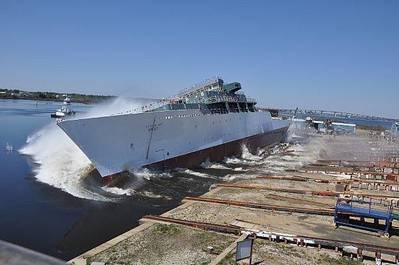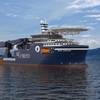Navy Christens, Launches New Oceanographic Survey Ship
Accompanied by azure blue skies and a stiff breeze, the Navy christened and launched its newest oceanographic survey ship, USNS Maury (T-AGS 66), the last of its class at VT Halter Marine’s shipyard in Moss Point, Miss., in a traditional Navy ceremony on March 27.
The 350-foot ship is named for Cmdr. Matthew F. Maury, considered to be the father of oceanography, nicknamed the “Pathfinder of the Seas” and the first superintendent of the U.S. Naval Observatory. Maury is 24 feet longer than its six sister ships to accommodate a 300 square-foot moon pool for easier deployment and retrieval of unmanned underwater vehicles.
Rear Adm. Jonathan White, Oceanographer and Navigator of the Navy and the principal speaker at the launch and christening, said the T-AGS ships are a reflection of Matthew Maury, who he said, “led a transformation in our Navy.”
Matthew Maury developed wind and tide charts in the 1840s from ship’s logs. White said that Maury realized the importance that understanding the natural environment has for ship operations. That lesson has persisted.
“We need to know about the environment to be the best navy in the world,” White said.
USNS Maury will survey the world’s oceans, collecting ocean data, for Navy operations, continuing the work in the 21st century that Matthew Maury started in the 19th. The ship will be operated by the U.S. Military Sealift Command (MSC) for the Naval Meteorology and Oceanography Command (NAVMETOCCOM).
“If Matthew Fontaine Maury was here today to see this ship and to see the character of the people who built it, there is no doubt he would say, ‘all’s well.’”
NAVMETOCCOM directs the Navy's meteorology, oceanography and hydrography programs, operates the Navy’s atomic clock for precise time and tracks the positions of the stars for navigation. The command is comprised of approximately 2,500 officer, enlisted and civilian personnel stationed around the world. Naval Oceanography enables the safety, speed and operational effectiveness of the fleet by identifying the risks and opportunities for naval and joint forces posed by the present and future battlespace.
MSC operates approximately 110 noncombatant, U.S. merchant mariner-crewed ships that replenish U.S. Navy ships, conduct specialized missions, strategically preposition combat cargo at sea around the world, and move military cargo and supplies used by deployed U.S. forces and coalition partners.













